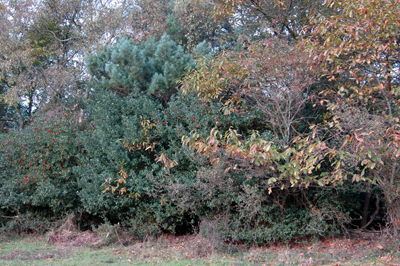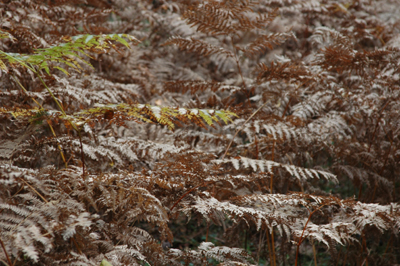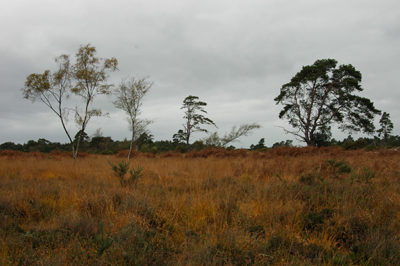Visit 9: 8 - 13 November 2006
Julie and I return to Holton Lee on Wednesday night, in preparation for two days' work with Trish and Hayley developing the NDACA database before we join with Tony and Louise, the arts administrator, for a day's training on the Calm software next Monday. Julie and I are saddened by the fact that her dog died the day after we returned to London from our last visit: after what appeared to be a good recovery from the stroke, the dog was suddenly hit by a massive infection and died in her sleep. Julie is somewhat comforted by remembering what a good time they had together when they came to Holton Lee for a disabled film-makers' weekend two years ago: as I am constantly reminded with Genie, Holton Lee is as much fun for animals as it is for humans. We are staying in Woodland Cottage, a piece of good luck for us after a visitor cancelled at the last minute. The cottage - actually twice the size of my terraced cottage in East London - is fully accessible, and is situated relatively close to the main road compared to the caravan which gives us a different perspective on the whole site. Rather than being close to the fields, we are next to the heathland, which is a very different habitat and is particularly beautiful at this time of year.
We arrive about 5pm, just as the office is packing up for the day. Tony greets us as he drives past in his van, while Trish stops to help us unload as well as bringing us the key. Wally and Denise have left us some shopping, as well as more flowers, and later stop by for tea and help us to unpack, which cheers us up no end. Later I take Genie out the back to relieve herself and discover that the ground is covered with mole hills - clearly moles do not hibernate (my question from last time), and either our close neighbour at the caravan has heard we are here and has moved down in preparation, or we are staying near its relatives. The absolute quiet is a great relief after London, where fireworks have been going off around the clock for the past ten days (don't get me started ...). Genie suffers from firework phobia, and is exhausted by it all - so am I as I have been sitting up with her until the 'curfew' and then getting up through the night whenever particularly loud rockets go off. The only sound here is a bird whistling loudly - well, something is whistling loudly, anyway. Consequently I feel better already when I get to the office the next morning, despite the fact that I also spent the previous weekend on a Graeae movement course for disabled performers, and actually haven't had a day off since I was last here because I'd spent the previous weekend at the York Lesbian Arts Festival with my publisher hat on.
This is the first time that I have seen the others since we heard that the Arts Council has confirmed the capital funding for the archive and has also increased the budget. All of the time that we spent working on the funding application over the summer has been well worth it, and we feel newly energised and excited about the project. Trish, Hayley and I spend a productive morning fine-tuning the work we did last time on the 'virtual' archive - from here on known as 'NDACA Web'. We had analysed all of the possible uses and users of the online version of the archive last time, and Hayley has produced a wonderful graph of this data complete with colour coordination. At lunch-time Genie and I go down to check on the caravan, which I am relieved to see is doing fairly well despite the weather being very cold and damp. I do find some signs of water penetration near the kitchen area, but eventually conclude that these have been there all along, but have previously been covered up by kitchen paraphernalia which has now been put away for the winter. When I inspect the outside I find two pin-sized holes which I assume are to blame - they were probably hidden by dirt until the caravan was washed down in September! I also take the opportunity to phone a bookdealer customer of my smallpress publishing company, Bettany Press, Sally Tall, who is also an archivist, and arrange to drive over to Taunton on Sunday to see her. It will be very interesting to get some feedback on our plans before the Calm training.
On the way back to the office I stop at Dave's garden project, and am impressed to see how much has been done since my last visit. Dave is recycling building materials that have until recently been part of the Barn wall, but have been demolished in order to build the extension. As part of this he is putting up some small outbuildings, as well as a polytunnel where the students will grow fruit and vegetables. He admits that in the process of digging the footings for the outbuildings he has cut through the project's telephone cables, but all is working again now! After another productive session in the office, Julie picks up Genie and I to return to the cottage. It is already very dark, and also very cold. Wally and Denise finish in the stables at about the same time, so collect fish and chips for us all from the nearest small town, Wareham. We enjoy a leisurely supper, and then finish the evening in front of the television. When I let Genie out last thing, the sky is very starry, and there is also a bright waning moon. Clearly the skies are more spectacular here over the winter months, but I am not sure I will spend huge amounts of time looking at them in the cold!
On Friday morning, I drive one of Holton Lee's Trampers - off-road electric scooters - down the lane to work. As I leave the cottage, squirrels are jumping through the trees like monkeys, giving an exotic feel to the woodland. I thoroughly enjoy my short trip in the open air, and notice that a hedger has been at work along the lane, twisting the branches into shape. My grandfather was a farmer in Suffolk, though he died before I was born and the farm was then sold. My father, who loved the countryside, always mourned the loss of the hedgerows in East Anglia, after vast field systems were created during and after the Second World War to increase grain production. Having seen the abundant wildlife at Holton Lee after the past few months, including the numbers of species who use or live in the hedgerows, I can understand why. I also really enjoy seeing the trees in the pale autumn morning sunshine, having gained a new appreciation of their beauty over the summer. Coming from the marshlands of Essex, and living for most of the past 21 years in East London, I haven't ever spent much time in woodland, and if anything have found trees slightly sinister in the past. (I usually do my landscape work on the Pembrokeshire coast, which is also pretty treeless.) Now I really appreciate why the oak, in particular, came to symbolise Britain, and am reminded that - apparently - I used to spend many an hour staring from my pram at the solitary row of pine trees at the bottom of the garden when I was a baby.
After a solid morning's work deciding what database 'fields' we need to create with the Calm software, the whole of the arts team plus Julie go out for lunch at a nearby village pub to celebrate the Arts Council's funding decision. We sit near a roaring fire, and the low natural light is supplemented by candles - what a contrast to London! I have sausages and mash - great, and sadly too tasty to leave any for Genie, who sleeps in the van while we eat. As we drive back up the lane to work, a pheasant strolls leisurely across it before exiting through a bird door in the fence. We finish the day by drawing up a list of main and associated links on the NDACA website, before I drive the Tramper back to the cottage for a relaxed evening in front of the television. After being so busy for the last two weekends, I am delighted to have some time for myself - although in fact we go to sleep at 9pm, still being exhausted. Although it rains in the night, Saturday turns out to be fairly dry - in contradiction of the weather forecast, fortunately. We get up slowly, and spent a great deal of time drinking coffee, and reading the paper which Denise has dropped off on her way to work as she has the last two mornings. This is a particular treat as I haven't had a paper to read in the mornings since developers closed down my local corner shop three years ago - the last time that I was able to access a shop independently. Then we separate to take photographs and enjoy the outdoors (Genie being incapable of walking quietly, Julie prefers not to be accompanied by her when trying to photograph the wildlife!). Julie takes the Tramper, while Genie and I go off with my scooter.
I have come to the realisation that I will have to do something about my transport needs now that the funding for NDACA has been confirmed and I will definitely be coming down here for at least 18 months. My mini-scooter, while far exceeding the manufacturer's claims for it, is just not up to off-road demands in the winter. Nor are the Trampers a solution for me, as they are operated by twisting and holding back the handlebar rather like a motorbike throttle. My right wrist is very weak from the after-effects of a long illness from 2000 onwards, and has also had surgery to sever the ligament in order to return the feeling to my hand. The Tramper that I used on Friday had left-handed controls, and it sobered me to realise that I actually had more control over my left hand than my right. However, being right-handed, I still found it hard to steer, while the permanent tendonitis that I experience made it hard to hold back the throttle on the left-hand side too. Accordingly I have found an off-road scooter that has fingertip control, and have booked a test drive in a fortnight's time.
This morning, though, my mini-scooter just manages to cope so long as I stick to the track, and Genie and I enjoy an hour's walk/roll round the heathland, Genie walking through every puddle that presents itself to her, but waiting obediently whenever I stop to take photographs. The autumn colours are gorgeous despite the sky being very overcast, and we are both very happy to be in the fresh air. It is still fairly cold, and I am grateful to Julie's mother, who found me a pair of almost-new heavy duty outdoor trousers in her local charity shop. Then we return to the cottage, where I spend the afternoon blogging and proof-reading Two Chalet School Girls in India by Priyadarshini Narendra, which I am just about to publish. A fawn wanders into the garden while I am working, but Genie fails to notice - she is too busy snoozing. The evening passes quietly in front of the television again, while I finish the proof-reading. Again in contradiction of the weather forecast, Sunday dawns bright and sunny (actually this is poetic licence - I do not wake in time to see the dawn, but by the time I am awake, it is bright and sunny). When I let Genie out to do her business after breakfast, we come face to face with a hind deer - well, technically only I do, since Genie is too busy looking for rabbits to notice. Before I can say 'hold it right there' and dash in for my camera - in retrospect never a very practical option - the deer decides to take no chances and vanishes back into the woodland at the bottom of the garden. Genie continues to look for rabbits, undisturbed. I vow that I will get a decent shot of the deer before Christmas, because it is now a matter of honour.
As we are about to leave for Taunton, Julie notices that the wild ponies are feeding just the other side of the cattle grid, and I stop to photograph them. They are so unafraid of people here that - unlike the deer - I am able to get really close to them; quite a special moment. Then we drive to Taunton via the A35 heritage coast road, which is the slow but scenic route. The countryside changes constantly, and I am reminded of how conveniently Holton Lee, and in fact the whole Poole area, is situated for visiting large parts of the south and south-west of England. We stop for a roast lunch at a pub just outside Honiton, where they insist on Genie coming in too - none of us are about to argue, and Genie thoroughly enjoys the experience. Since it is virtually unheard-of for Julie and I to eat out twice in a week, so do we, particularly as the service is so friendly. After this we cut across country to the M5, and finish the journey at about three times our previous speed! Janet and her husband Nic from Badger Books make us very welcome, as do their children - Emily, aged almost three, and Simon, aged one - who are incredibly sociable and who quickly involve me in the new sport of Bagpuss-tossing. Perhaps one for 2012? Janet turns out to have designed and implemented the Calm database for the Somerset Records office and invites me to come over another time to see it in use; an offer that I can't refuse. We are also able to have an enjoyable talk about the children's book world and the impact of the internet on collecting and dealing, and inevitably we buy some books off them too before we go. The non-scenic route back takes half the time; just as well since we need to get semi-packed before going to bed in readiness for a prompt departure to London straight after the Calm session tomorrow. The next day, Calm session goes very well. The trainer, Julia Murray, is a museum curator by profession and is able to make many useful comments on our customisation plans. The software will allow us to follow international standards in archiving: it is very important that NDACA meets the highest professional as well as access standards. Fortunately there is a facility for us to add Plain English versions of the 'help' information - archivists do not seem to use the same language as the rest of us, and we need to enable volunteers to help with inputting the initial data. After that we make a swift exit for the carpark that is the M3, as I am joining a 'people's jury' at the Disability Rights Commission tomorrow to feedback on their Disability Equality Scheme and Action Plan. I am secure in the knowledge that Trish and Hayley have plenty to be getting on with!
Click here to read the next entry Click here to return to the blog entries Click here to return to the top of the page All contents © 2006 |











